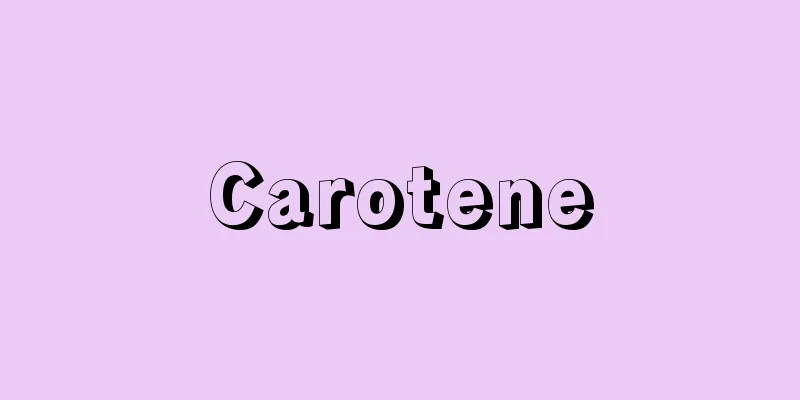Carotene

|
A general term for carotenoid hydrocarbons such as α- and β-carotene and lycopene. It can also refer to a mixture of naturally occurring carotenoid hydrocarbons. It appears as yellow or reddish purple crystals, soluble in hydrocarbon solvents, poorly soluble in alcohols, and insoluble in water. It is more weakly adsorbed by chromatography than xanthophylls. The four main types of carotene are as follows: [ I ] α-carotene: C 40 H 56 (536.85). It is widely distributed in the plant kingdom in association with β-carotene, but the amount is usually less than half that of β-carotene. It is separated by chromatography from carotene mixtures obtained from natural products. The raw materials used include carrots (Daucus carota) of the Umbelliferae family and palm oil. It is also found in the animal kingdom. Purple-red columnar crystals. Melting point 187-188 °C (in a sealed tube). +385 °C (benzene). λ max 475, 445, 420, 395 nm (hexane). It has about half the provitamin A activity of β-carotene. [CAS 7488-99-5] [ II ] β-carotene: C 40 H 56 (536.85). It is the most widely distributed and abundant carotenoid hydrocarbon, found in the green parts of plants, flowers, fruits, roots, animal blood, organs, fat, eggs, milk, etc. It was isolated from natural sources such as carrot (Daucus carota) of the Umbelliferae family, spinach (Spinacia oleracea) of the Chenopodiaceae family, and palm oil, but it is now synthesized in large quantities industrially. Dark red plate-like crystals. Melting point 183 °C (in a sealed tube). λ max 482, 450, 425 nm (hexane). Soluble in chloroform, benzene, and petroleum benzine, but sparingly soluble in methanol and ethanol. It is the most important provitamin A. It is used to color food and feed and to enhance vitamin A activity. [CAS 7235-40-7] [ III ] γ-carotene: C 40 H 56 (536.85). It is contained in about 0.1% of carrot carotene, and is often found in fruits and flowers of other plants, but the amount is very small. Red columnar crystals. Melting point 178 °C. λ max 494, 462, 431 nm (hexane). It has about half the provitamin A activity of β-carotene. [CAS 472-93-5] [ IV ] δ-carotene: C 40 H 56 (536.85). It is distributed in many plants such as carrots and tomatoes. Scarlet-orange columnar crystals. Melting point 140.5 °C. +352° (±16% hexane). [CAS 472-92-4] Source: Morikita Publishing "Chemical Dictionary (2nd Edition)" Information about the Chemical Dictionary 2nd Edition |
|
α-,β-カロテンやリコペンなどのカロテノイド炭化水素の総称.天然に存在するカロテノイド炭化水素の混合物をさすこともある.黄色ないし赤紫色の結晶で,炭化水素系の溶媒に可溶,アルコール類に難溶,水に不溶.クロマトグラフィーにおいてはキサントフィル類より弱く吸着される.主要な4種類のカロテンを次に示す.【Ⅰ】α-カロテン:C40H56(536.85).植物界にβ-カロテンに付随して広く分布しているが,量的には,通常,β-カロテンの1/2以下である.天然物から得られるカロテン混合物から,クロマトグラフィーによって分離する.セリ科のニンジンDaucus carota,やし油などが原料に用いられる.また,動物界にも見いだされる.紫赤色の柱状結晶.融点187~188 ℃(封管中).+385°(ベンゼン).λmax 475,445,420,395 nm(ヘキサン).β-カロテンの約1/2のプロビタミンA作用をもつ.[CAS 7488-99-5]【Ⅱ】β-カロテン:C40H56(536.85).もっとも広く分布し,量的にも多く存在するカロテノイド炭化水素で,植物緑色部,花,果実,根,動物の血液,臓器,脂肪,卵,乳などに見いだされる.天然からの単離にはセリ科のニンジンDaucus carota,アカザ科のホウレンソウSpinacia oleracea,やし油などが用いられたが,現在は,工業的に大量に合成されている.暗赤色の板状結晶.融点183 ℃(封管中).λmax 482,450,425 nm(ヘキサン).クロロホルム,ベンゼン,石油ベンジンに可溶,メタノール,エタノールに難溶.もっとも重要なプロビタミンAである.食品,飼料の着色やビタミンA作用強化に用いられる.[CAS 7235-40-7]【Ⅲ】γ-カロテン:C40H56(536.85).ニンジンカロテン中に約0.1% 含まれ,そのほか植物の果実や花にしばしば見いだされるが,含有量は非常に少ない.赤色の柱状結晶.融点178 ℃.λmax 494,462,431 nm(ヘキサン).β-カロテンの約1/2のプロビタミンA作用をもつ.[CAS 472-93-5]【Ⅳ】δ-カロテン:C40H56(536.85).ニンジンやトマトなど多くの植物に分布する.朱橙色の柱状晶.融点140.5 ℃.+352°(±16% ヘキサン).[CAS 472-92-4] 出典 森北出版「化学辞典(第2版)」化学辞典 第2版について 情報 |
Recommend
Harald I
?‐931? The first king of Norway to unify the count...
Freitas Branco, L.de (English)
…In the 19th century, the influence of Italian op...
Airedale terrier [breed] (English spelling)
A hunting dog and police dog that originated in th...
Toll signal - Toll signal
...Supervision signals are signals used to monito...
Cable broadcast telephone - Yusenhosodenwa
Telephone/broadcasting equipment that mediates oth...
Polar Group
A polar atomic group, which, when present in an or...
Şeyh Sait (English spelling) SeyhSait
In February 1925, the Kurds rebelled against Pres...
fleuret
…In 1653, the Frenchman Besnard published a manua...
Metal casting
A type of metalwork using casting techniques. Mate...
Indian medicine - Indian medicine
Indian medicine, systematized as Ayurveda (science...
smörgåsbord (English spelling) smorgasbord
...Meat dishes include meatballs made from minced...
Koshi-ko - Kinoeneko
…He was also worshipped as the god of the fields,...
Mizzia (English spelling)
A calcareous alga of the Chlorophyte family, M. ve...
Eye ointment
…Medicines used to treat eye diseases. Eye drops ...
Manchu - Manshu-zoku (English spelling) Manchu
Also called Manchu. A group of people who speak a ...









